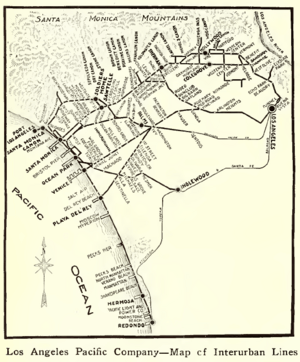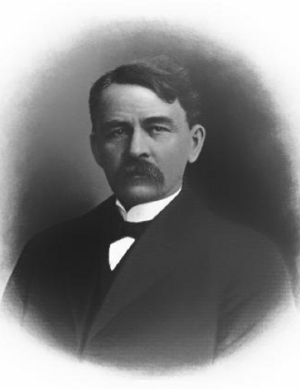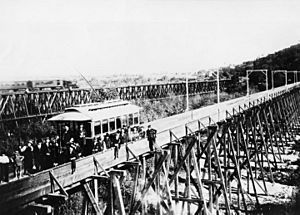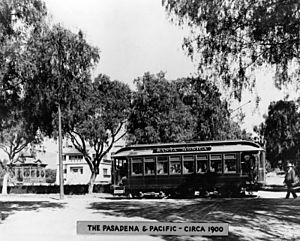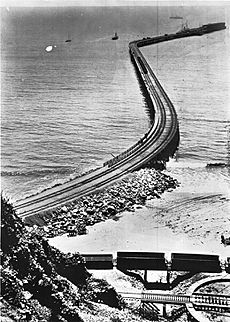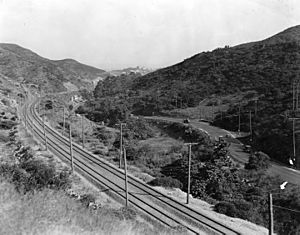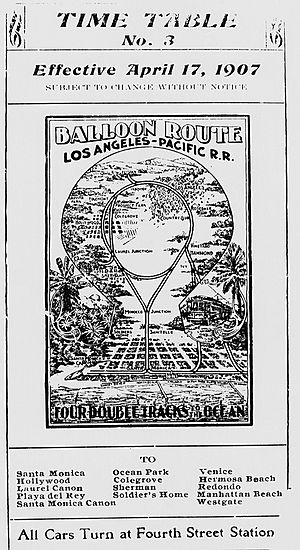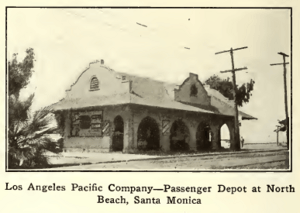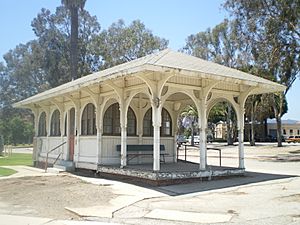Los Angeles Pacific Railroad facts for kids
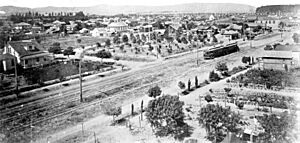
The Los Angeles Pacific Railroad (LAP) was an electric railway system that operated from 1896 to 1911 in Los Angeles County, California. It carried both people (public transit) and goods (freight). At its busiest, it had about 230 miles (370 km) of track. These tracks stretched from Downtown Los Angeles all the way to the Westside, Santa Monica, and the South Bay towns along Santa Monica Bay.
Contents
How It Started
Sherman and Clark's Vision
Moses Sherman was a teacher who had experience building streetcar lines in Arizona. He saw a great opportunity for similar systems in Los Angeles. In 1890, Sherman and his brother-in-law, Eli P. Clark, started buying and connecting old railway lines. They also built new ones for a narrow-gauge street railway called the Los Angeles Consolidated Electric Railway Company (LACE). They also bought and updated horse-drawn streetcar lines in Pasadena to run on electricity.
On April 11, 1894, Sherman and Clark created the Pasadena & Los Angeles Electric Railway Company (P&LA). This was Southern California’s first "interurban" line. An interurban line connects cities, like a longer streetcar line. This new line linked Pasadena's streetcars with the LACE system in Los Angeles.
Building to Santa Monica
In November 1894, they formed another company, the Pasadena & Pacific Electric Railroad Company (P&P). Their goal was to build a second interurban line from Los Angeles to Santa Monica.
Building all these lines was very expensive. Sherman and Clark faced money problems. In March 1895, a group of investors took over the LACE lines and formed the Los Angeles Railway Company (LARy). Sherman and Clark managed to keep their P&LA and P&P lines.
The line connecting Pasadena and Los Angeles officially opened on May 4, 1895.
Construction of the electric line to Santa Monica began on June 11, 1895. It was a narrow-gauge line that went through an area called Colegrove. Sherman and Clark made a deal with LARy to use their tracks to get into downtown Los Angeles. They built train repair shops and a rail yard halfway between Los Angeles and Santa Monica. They named this area "Sherman," which later became West Hollywood. Local promoters helped them get land near the Soldier’s Home. Sherman and Clark sold this land to help pay for construction. This property became part of Sawtelle.
On April 1, 1896, the first train arrived in Santa Monica, passing through fields of wildflowers. Everyone celebrated its arrival.
On November 9, 1896, they formed the Pasadena and Pacific Railway Company of California. They built a new line from Los Angeles, known as the Sixteenth Street Division. This line went through West 16th Street (Venice Boulevard) to Beverly. This new route was two miles shorter and faster to the beach than the Colegrove line. It was called the “Santa Monica Short Line” and opened on July 1, 1897.
More money problems came up. The P&LA company had trouble paying its debts in 1897. In January 1898, the company was forced into a legal process called receivership. The P&LA was sold on April 27, 1898, and then reorganized as the Los Angeles-Pacific Electric Railway Company. Henry E. Huntington bought this company and the local Pasadena lines in late 1898. This left Sherman and Clark with their western lines and a good profit.
The Los Angeles-Pacific Railroad Company Grows
On June 4, 1898, Sherman and Clark created a new company called the Los Angeles-Pacific. They combined their existing lines into this new company. They often created new companies for new lines, then merged them into a larger company.
On December 15, 1899, Sherman and Clark started a line on Prospect Avenue in Hollywood. This street was renamed Hollywood Blvd in 1910. Many people paid extra money to the LAP to help build these lines. This was a common way for Sherman and Clark to fund their projects.
The year 1902 was very busy for the company. A special private track, called the Trolleyway, was built between Santa Monica and Venice.
The Palms Division was also built. This line went from Vineyard through Ivy Station (which later became Culver City) to Ocean Park. This line, called the Venice Short Line, became LAP’s most popular route. A new power station was built in Ocean Park to provide more electricity for the growing system. The company also bought new trains to handle the extra passengers.
The Santa Monica Short Line and the Venice Short Line became very popular. They took away many passengers from the Southern Pacific and Atchison, Topeka and Santa Fe Railway train companies. The LAP even bought a line from Santa Monica to Inglewood after the Santa Fe company stopped using it. This was the only standard-gauge line LAP owned at the time. (Most of their lines were narrow-gauge).
By June 1902, the company had over 102 miles (164 km) of track.
In September 1902, the Los Angeles, Hermosa Beach and Redondo Railway Company was formed. Its goal was to build a line down the coast. The Del Rey Division was built from Ivy to a new resort called Playa Del Rey. Sherman and Clark were big investors in this resort. This line opened on December 7, 1903. It was followed by a line from Playa Del Rey to Redondo Beach, which opened in late summer 1904. The Redondo line passed through Hermosa Beach, where Sherman and Clark also had major investments.
With the Redondo and Del Rey lines growing, the Los Angeles, Hermosa Beach and Redondo Railway Company merged into a new company. This new company was the Los Angeles Pacific Railroad Company of California, formed on June 16, 1903. Another line, the Los Angeles-Santa Monica Railroad Company, also joined this merger.
In 1903, a new, larger power station was built at Vineyard. This replaced older power equipment and the Ocean Park power station.
In 1905, the Lagoon line, which ran from Santa Monica to Venice, was extended to Playa Del Rey. In 1906, when a new neighborhood called Brentwood Park was being built, LAP built tracks for the Westgate Line. This line ran on San Vicente Boulevard to Ocean Avenue (Santa Monica) and then turned south.
In February 1906, there were rumors that E. H. Harriman, who ran the Southern Pacific Railroad, had bought the Los Angeles Pacific. Clark denied these rumors at first. But in March 1906, it was confirmed that Harriman had indeed bought control of the Los Angeles Pacific. Sherman had asked Harriman to help with LAP's finances, and Harriman agreed, but only if he got control of the company. Sherman and Clark continued to manage the company for a while.
The Los Angeles Pacific Company
The Southern Pacific company created a new company on April 4, 1907, called the Los Angeles Pacific Company. It was worth $20,000,000. Most of the shares were held by Epes Randolph for Harriman.
From 1907 to 1909, almost all of the company’s narrow-gauge tracks were rebuilt to standard-gauge. This meant they were wider and could handle bigger, more powerful trains.
There were plans for a subway from Fourth Street to Vineyard, and a large train station. They also planned to add more tracks to the Venice Short Line and build tunnels near the Hill Street station for the Hollywood line. However, a financial crisis in 1907 and other projects stopped these plans. The Pacific Electric Railway later built a different subway and the Subway Terminal Building in the 1920s.
In 1908, LAP leased the Southern Pacific Santa Monica Line (the Air Line) and the Long Wharf. They added electricity to the Air Line from Santa Monica to Sentous. This became a key spot for transferring freight with the Southern Pacific.
In 1909, the company did build two tunnels north of the Hill Street Station. These tunnels made it easier for trains from Hollywood and Colegrove to enter Los Angeles. They opened on September 9, 1909, and cut 10 minutes off travel time. They also started planning a line to the San Fernando Valley. The Pacific Electric Railway eventually completed this line in 1912.
By October 1909, the Los Angeles Pacific had grown to 213.5 miles (343.6 km) of track, all of which were now standard-gauge.
1911: LAP Joins Pacific Electric
Sherman and Clark remained small owners and managers of the company until May 28, 1910. Then, they sold their remaining shares to Southern Pacific and retired. Southern Pacific then convinced Huntington to sell his shares in the Pacific Electric Railway.
On September 1, 1911, a big event called “The Great Merger” happened. Southern Pacific combined seven electric railway companies into the new “Pacific Electric Railway Company.” The Los Angeles Pacific lines, along with others, became the Pacific Electric’s Western Division.
When it joined the new Pacific Electric Railway in September 1911, the Los Angeles Pacific brought with it:
- 204.67 miles (329.39 km) of tracks it owned
- 26.20 miles (42.16 km) of tracks it leased
- 172 passenger cars
- 194 freight cars
- 25 service cars (for maintenance)
- $21 million in stock and $14,201,000 in bonds (money owed).
Train Lines
LAP passenger trains offered local service in cities like Los Angeles, Pasadena, Hollywood, Sawtelle, Santa Monica, and Ocean Park.
LAP’s most popular interurban lines (connecting cities) included these four:
- Santa Monica Short Line – From Hill Street in Los Angeles to Santa Monica, Ocean Park, and Venice.
- Venice Short Line – From Hill Street to Venice, Ocean Park, and Venice.
- Hollywood Line – From Hill Street to Gardner Junction in Hollywood.
- Redondo Beach via Playa del Rey Line – From Hill Street to Manhattan Beach, Hermosa Beach, and Redondo Beach.
Other important interurban lines were:
- Colegrove Line – From Hill Street to Santa Monica, Ocean Park, and Venice through Colegrove (South Hollywood) and Sherman.
- Western and Franklin Avenue Line – From Hill Street to Hollywood and Vine.
- Westgate Line (Brentwood) – From Hill Street to Santa Monica (North Beach).
Local service was mainly on these lines:
- Lagoon Line – From Santa Monica to Playa Del Rey. This line was very popular on beach days. Part of its route used a private track called the Trolleyway.
- Brush Canyon Line – From Franklin Avenue north to a quarry.
- Highland Line – From Santa Monica Boulevard north to Cahuenga Pass. This line was being extended to the San Fernando Valley when LAP merged with other railways.
- Elysian Park Line – From Sunset north on Echo Park Avenue.
- Rodeo Line – From Santa Monica Blvd north on Rodeo Drive to the future Beverly Hills Hotel.
- South Loop, North Loop – Local lines within Santa Monica.
- Santa Monica Air Line – From Fourth Street station to Santa Monica. It mostly carried freight, but one passenger car ran daily.
- Inglewood Line – From Santa Monica to Inglewood. Mostly used for freight, but a single daily passenger car ran to keep the company's right to operate.
- Santa Monica Canyon Line – From Santa Monica to Port Los Angeles.
- Laurel Canyon Line – From Hill Street to Laurel Canyon Blvd. In 1910, it had a special electric "Trackless Trolley" at its end that served a community called “Bungalowtown.”
- Soldier’s Home – From Sawtelle Station on Santa Monica Blvd, north to the Soldier’s Home.
- Motordrome Spur – A short track off the Redondo Line, near Playa Del Rey. It served a car racetrack called an auto Motordrome from 1910 to 1913. Famous drivers like Barney Oldfield raced there.
The Famous Balloon Route
The Balloon Route Trolley trip was a very popular sightseeing tour offered by the Los Angeles Pacific. It started in 1901.
At first, the tour started at the Hill Street station in downtown Los Angeles. It went through Hollywood to Santa Monica and Ocean Park. Then, it returned to Los Angeles through Palms using the Venice Short Line.
As the railway system grew, the tour also expanded. By 1909, the special tour cars (sometimes in multiple-car trains) made these stops:
- From the Hill Street station, through tunnels, to the art studio of painter Paul de Longpré on Sunset Boulevard.
- Through farms and bean fields to the area that would become Beverly Hills.
- A stop at the Old Soldiers' Home above Sawtelle for photos.
- A ride onto the Long Wharf north of Santa Monica.
- A stop at the Camera Obscura in Santa Monica, a device that projects images.
- A stop at the Playa del Rey Pavilion for a fish dinner.
- A ride along the beach to Redondo's Moonstone Beach.
- A return trip up the beaches to Venice.
- A final return downtown via Palms on the Venice Short Line.
This tour was heavily advertised. Brochures and ads called it “101 miles for $1.00,” or "a 10-dollar tour for one dollar.” The first car used was a fancy Parlor car (#400). As the tour became more popular, more cars were added. Eventually, larger 700-class cars made it possible to run multi-car trains. Tours left downtown Los Angeles at 9:30 AM each day and returned by 5:00 PM.
When Harriman and Southern Pacific took over LAP in 1906, they continued the tours. When LAP merged into the new Pacific Electric Railway Company (PE) in 1911, PE took over the tours and continued them until 1923.
The old Balloon Route Streetcar Depot, West Los Angeles has been recognized as a historic place since 1972.
Train Cars
In 1906, the company owned and operated 405 cars. These included 144 passenger cars, 6 special parlor cars, 17 electric locomotives, 221 freight cars, 5 mail cars, and 12 repair service cars.
LAP had different types of cars. Here’s what they had in April 1911:
Passenger cars were motorized cars that carried people, or non-motorized trailers that were pulled by the motorized cars. Passenger cars changed over time as the system improved. LAP bought groups of cars and gave them series numbers. For example, they bought the 60-series cars in 1895-96 and numbered them 60-69.
The first cars, bought in 1895-96 from Pullman and Brill, included the motorized 60- and 70-series, and the non-motorized 40-series trailers. These cars had two 43-horsepower motors and could carry up to 48 passengers. They also had the special 5-window design that became common for LA streetcars.
After 1902, as LAP built more lines, they bought larger and more powerful cars. These included the 180- and 190-series from the American Car Company, along with 48-series trailers. Most of these cars had open sections on one or both ends and were called California cars. In 1904-05, LAP bought 50 new 48-passenger cars from the St. Louis Car Company, numbered as the 200-series. But even with two 57-horsepower motors, these cars were not powerful enough for heavy interurban use.
Once Southern Pacific took control, more money became available. LAP bought 50 heavy-duty cars from the St. Louis Car Company, numbered as the 700-series. These cars were much larger, could carry 56 passengers, and had four 75-horsepower motors. This was more powerful than the two motors most older cars used. These new cars were immediately put to use on the Venice Short Line and Santa Monica Short Line.
Some cars were fancier than regular ones. These included Observation cars used for the Balloon Route tour (especially car 400). There was also the beautiful “El Viento” for LAP’s officers and the “Mermaid,” which was Sherman’s private car.
Some cars were built or changed at the Sherman Shops. New passenger cars might get stronger supports, or different brakes or motors. Old passenger cars could be turned into Line or Maintenance cars. The shops even built electric locomotives from older cars.
Freight and Express cars – LAP had many freight cars to carry goods. These included over 60 flat cars, 13 box cars, over 100 dump cars, and 15 oil cars. The company also had 15 cars that carried express freight and mail.
Service cars had many uses. These included tower cars for fixing overhead wires, a bonding car to connect rails electrically, a wrecker to clear train accidents, a portable power station, work motors to move cars and construction crews, a vacuum car that cleaned passenger cars, a weed burner, a sprinkler, and a gondola car for trash.
Buildings and Facilities
Stations
- Fourth Street Station – The first passenger station in downtown Los Angeles was at 222 West Fourth Street. It was shared with the Pasadena and Los Angeles Electric Railway. There was no rail yard, so passengers got on and off trains in the street.
In 1900, the Los Angeles Pacific Railroad waiting room and offices moved to a larger building at 314 West 4th Street. This was next to the Broadway Department Store in Downtown Los Angeles. Passengers still had to get on and off trains in the street.
- Hill Street Station – After the system started to use standard-gauge tracks, a new station and yard were built in April 1908. This was at 439 South Hill Street, between Fourth and Fifth Streets. Trains arriving on the West 16th Street line used this station. However, the narrow-gauge trains from Hollywood and Colegrove still used the Fourth Street station.
A fire on November 15, 1908, destroyed the Fourth Street offices. This forced the company to move its offices to the Masonic Temple on Hill Street, next to the Hill Street station. The nearby rail yard was changed to handle both the East 16th Street and Hollywood trains.
- Other Stations – Brick stations were built in places like Santa Monica, Hollywood, Ocean Park, Beverly, Playa Del Rey, Hermosa Beach, Sawtelle, and Sherman. Simpler wooden stations were in Port of Los Angeles, Santa Monica, Palms, Soldier’s Home, Ocean Park, Venice, and Redondo.
Maintenance Facilities
In 1896, the Pasadena and Pacific Railway Company bought land on Santa Monica Boulevard. This was about halfway between Los Angeles and Santa Monica. They built a rail facility there. This place, called “Sherman” (after Moses Sherman), had a steam power station, a car barn, repair shops, and over two miles of tracks for storing cars. The nearby town was also named "Sherman," and it eventually became the city of West Hollywood.
In October 1906, the Harriman interests bought more land there. They added more shop buildings in mid-1907. In 1912, the Pacific Electric Railway moved all major repair services to their shops in downtown Los Angeles. However, the Sherman facility stayed open for smaller local repairs.
Other rail yards were at the Buena Vista freight depot and the Hill Street Station.
Electrical Power
- The first lines got their electricity from a steam-powered facility at Sherman. After an explosion damaged this plant, and because the new Venice Short Line needed more power, a second power station was built in December 1901 at Ocean Park. While these were being built, the Los Angeles Railway supplied power to LAP.
- As the system grew even more, LAP built a much larger power station in September 1903. This was at a place called Vineyard, where the Palms Division (Venice Short Line) and the Santa Monica Short Line crossed. Vineyard became the company's main power station. It used a special steam turbine to create 2400 AC volts of electricity. Vineyard was expanded several times between 1904 and 1906. By the time heavy-duty trains were used, there was plenty of power.
- Substations converted the 2400 AC volts to the 600 DC volts that the streetcar motors used. These substations were located at Bush Street and Burlington Avenue, West Olive Street, Ivy Park (Culver City), Playa del Rey, Hermosa, Ocean Park, and Sherman.
Other Facilities
- Hill Street Tunnels – In 1908 and 1909, two tunnels were dug north of the Hill Street Station. These made it faster for trains coming from Hollywood to reach the station. The tunnels opened on September 15, 1909, and cut 10 minutes off travel time from the Hollywood area.
- Long Wharf – The Long Wharf was built by Southern Pacific in 1893. It was meant to be a big harbor. However, San Pedro was chosen as Los Angeles’ main harbor instead. So, the Long Wharf became less important. In 1908, LAP leased this facility and its tracks. They used it to receive lumber until 1911. In 1908, LAP also included it as part of the popular Balloon Route tour.
Carrying Goods and Mail
Moving freight (goods) was very important for LAP. As early as 1898, they used electric trains to carry boxes of lemons from farms in Colegrove and Hollywood. These lemons went to Los Angeles for local use or to Ocean Park. At Ocean Park, they were transferred to Santa Fe trains (because the tracks were different widths) to be shipped to cities in the eastern U.S. Early freight also included crushed rock from the Laurel Canyon area. This rock was used to build the railway tracks. Oil for the power stations was carried by steam trains on a special Oil Spur line built in 1900. Also, in 1900, LAP won a contract to deliver mail to Santa Monica.
As the railway system grew, freight became even more important. By 1901, there were 11 freight stations across the system that could send and receive goods. LAP built 5 electric locomotives in their Sherman Shops to help with all the traffic.
By 1902, LAP bought the Santa Fe’s Inglewood branch line. They used steam trains on this line until it was electrified in October. Now, LAP could collect freight from all over its growing system. They could transfer it to box cars in Ocean Park and move it to Inglewood for transfer to the Santa Fe. To help with this, a larger freight depot was built at Ocean Park. This allowed LAP to deliver all the lumber for the Ocean Park Lumber Company.
By 1903, as LAP generated more electricity, it could increase its freight services. There were now three freight trains a day: one at 5 AM to Santa Monica (delivering newspapers, fruit, and vegetables), a long-distance freight train at 7 AM, and a local freight train at 1 PM.
LAP built a short track off 26th Street in Santa Monica for a local brickyard. This new track helped LAP get more freight business. It also allowed shipments to be transferred to Southern Pacific boxcars for further delivery.
As freight handling continued to grow, a new freight house was built in April 1905. This was the Buena Vista Freight House, located at Sunset and North Broadway. It had ten tracks and handled freight, express shipments, and passengers. In May 1905, six new express motors were added to handle the increased business.
Once the Harriman/Southern Pacific interests took control in 1906, and the system's tracks and cars were made wider (broad-gauged), LAP could expand freight services even more. In 1908, they leased Southern Pacific’s Air Line, which brought new business. Sentous became the main place for transferring freight between LAP and Southern Pacific.
The many lines spreading out from Los Angeles made LAP very important to the communities on the west side. Starting in 1907, a newspaper train delivered Los Angeles papers to Redondo Beach. Express and mail trains made deliveries to various parts of the system every day. Local deliveries within towns were made using wagons.
By 1909, the system had 17 electric locomotives, 225 freight cars, and 5 mail or express cars. There was a freight terminal in every town of a decent size. Along with regular freight, LAP transported large amounts of goods like crushed stone, oil, lumber, and citrus fruits. These were usually shipped late at night until early morning when more electricity was available.
By 1911, daily shipments had increased. After the "Great Merger" in September 1911, LAP tracks were connected to Pacific Electric. The Buena Vista freight house was closed, and all freight was sent to Pacific Electric’s Freight House.
What's Left Today
Historians say that the amazing growth of the beach communities and other towns along the trolley lines was thanks to these lines. They brought new people who bought land and brought fun-seekers to the beaches. Sherman and Clark’s electric lines and their real estate projects worked together to make this happen.
The current Sherman Way G Line station is on the path of a line that LAP planned and Pacific Electric completed. Sherman Way is named after General Sherman, because of his land development and the train lines he built in the valley.
- Ivy Substation - 9070 Venice Blvd, Culver City, CA.
- Burlington Substation - 1147 West Venice Blvd, Los Angeles, CA - now an auto upholstery shop.
- West Olive Substation, built in 1905, now Epitaph Records, 2798 W. Sunset Blvd., Los Angeles.
- Site of Ocean Park Carhouse - now Metro Division 6, 100 Sunset Ave, Venice.
- Site of Sherman Shops – now West Hollywood, Metro Division 7 and Pacific Design Center.
- Air Line – now Metro E-Line/Expo Line.
- Palms-Southern Pacific Railroad Depot - Heritage Square, 3800 N. Homer St, Montecito Heights, CA.
|


